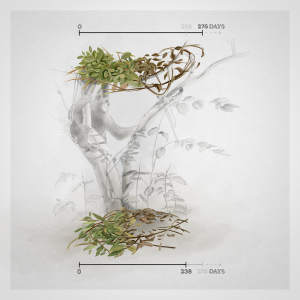A team of international researchers has conducted a study on the comparison of decay rates of chimpanzees ground and tree nest in the Bugoma Central Forest Reserve in western Uganda. The results are published in the prestigious “American Journal of Primatology”. The main author of the paper is Toni Romani, doctoral candidate at the Faculty of “Artes Liberales”, University of Warsaw.
The article Decay rates of arboreal and terrestrial nests of Eastern chimpanzees (Pan troglodytes schweinfurthii) in the Bugoma Central Forest Reserve, Uganda: implications for population size estimates is the result of the first research published comparing decay rates of chimpanzee tree and ground nests.
In the course of the study, the researchers have found that chimpanzee ground nests had decayed faster than tree nests. If this pattern is similar in other areas, it has implications for the documentation of ground nesting in chimpanzee populations as well as chimpanzee density estimations.
The main author of the paper presenting the results is Toni Romani of the Faculty of “Artes Liberales”, who is a doctoral candidate in the UW’s Nature-Culture program, under the supervision of Dr. Thurston Cleveland Hicks and Prof. Marek Konarzewski. Other co-authors of the paper are affiliated with the Cognitive Ethology Laboratory, the German Primate Center – Leibniz, the Department for Primate Cognition – Göttingen, the Bugoma Primate Conservation Project, the College of Natural Sciences at Makerere University – Uganda, the School of Psychology and Neuroscience at the University of St Andrews and the Swiss Center for Affective Sciences and the Faculty of Psychology and Educational Sciences at the University of Geneva.
The main goal of the study was to achieve a better understanding of the factors that affect nest survival rates, and therefore the probability to miss ground nests during surveys.
Findings
The researchers constructed a logistic regression model based on 55 ground and 49 tree nests, finding that ground nests disappeared 38 days before tree nests, a significant difference. The nests Romani and co-authors followed over the course of the study, which had been constructed using the tree species Omusetera (Maerua sp.), had not disappeared after one year. In a subset of 15 ground and 19 tree nests, terrestrial nests reached a more decayed age category more rapidly than arboreal nests.
This difference may be related to the plant species used in nest construction. In areas in which chimpanzees nest frequently on the ground, an update is proposed to the formula commonly used to estimate chimpanzee densities: the nest decay rate term should be weighted by the percentages of ground and tree nests counted.
Details of the paper
T. Romani, R. Mundry, G. Mayanja Shaban, M. Konarzewski, M. Namaganda, C. Hobaiter, T. Gruber, T. C. Hicks, Decay rates of arboreal and terrestrial nests of Eastern chimpanzees (Pan troglodytes schweinfurthii) in the Bugoma Central Forest Reserve, Uganda: Implications for population size estimates, “American Journal of Primatology”, 2023, DOI: http://doi.org/10.1002/ajp.23536




